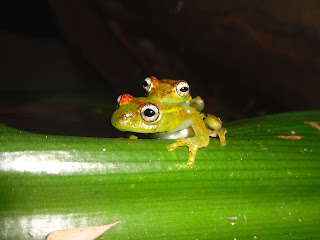“The collapse of compassion in people is the
Earth’s biggest threat. If we begin to care for more than just ourselves, we
will reverse the damage.”
- Cindy
Milburn, Senior Advisor, IFAW
Today I'm going to talk about my time in Madagascar, and when I say I could talk for hours about it, I really mean that...but if I did that, the main conservation issues would probably get lost in a sea of anecdotes about battery hens, fire starting locals and jumbo score...so I'll try and stick to the point. There's a lot to talk about, so I've decided to divide it into three parts: 1. Sahamalaza 2. Deforestation 3. Traveling
The data collection period of my MSc took place in the Ankarafa forest, which is situated on the Sahamalaza peninsula in northwest Madagascar. The Sahamalaza Iles-Radama National Park and UNESCO biosphere reserve are located on the peninsula, and the Ankarafa research station is located within the National Park, two hours hike from the coast at Maravato. The research station is funded by an international NGO; The Association European pour l'Etude et Conservation des Lemuriens, or for those of you who don't speak french, The European Association for the Study and Conservation of Lemurs. I'll talk more about them as an organization in a future post. Their executive secretary, and the founder of the camp also happens to be the head of research for Bristol Conservation & Science Foundation, and my primary supervisor, Dr Christoph Schwitzer - hence how I got this amazing opportunity in the first place.
The Ankarafa forest is primarily divided into four fragments, surrounded by savannah and with a river valley running through the middle. The picture below is a basic map, created using GPS waypoints, of the four main forest fragments, and the location of the research station (sorry it's so small!):
Within these fragments live an unimaginable amount of amazing creatures, with the presence of a number of endangered lemur species being the reason for AEECL's focus on this area.
The blue eyed black lemur (Eulemur flavifrons), studied by myself and Jana:
CRITICALLY ENDANGERED
The Sahamalaza sportive lemur (Lepilemur sahamalazensis), studied by Melanie, and the focus of her three year Phd:
DATA DEFICIENT (officially, this means there isn't enough data for IUCN to put this species into a category, but I think Melanie would tell you that it is most definitely Critically Endangered and will probably go EXTINCT over the next few decades)
Other lemur species present include the giant mouse lemur (Mirza zaza) and the fat-tailed dwarf lemur (Cheirogaleus medius), classed as 'vulnerable' and 'least concern' respectively. There are also numerous other animal species, such as the bats that Helen was researching...
and the amphibians and reptiles which Sam studied. Incredibly, one of the frog species Sam recorded as being present is highly likely to be a species never described before, from the genus Boophis (the bright eyed tree frogs); "This colorful species of bright eyes tree frog is known only from one small forest fragment on the Sahamalaza peninsula. The area's high levels of habitat destruction make this species future extinction a very real possibility" .
The discovery of this new species will hopefully add weight to the status of Ankarafa as a protected area, which is brilliant. To read more about some of the other frog species Sam encountered in and around Sahamalaza, visit his blog:
http://www.sahonagasy.org/the-search-for-two-critically-endangered-frogs-in-north-western-madagascar
Since our group has come back from Madagascar, some other Masters students have traveled out there, and the continued use of the field station supposedly keeps illegal activities, such as logging and slash & burn tavvy fields, at a lower level. In the next post, you will see that this is not necessarily the case, and that there is a huge need for Sahamalaza (and I'm sure other national parks in Madagascar), to have park rangers with the power to arrest individuals undertaking illegal activities.
As always however, it is important to give local inhabitants an alternative, and so far it's my opinion that this has not yet been achieved to the level it needs to be in Ankarafa. Whilst we were working there we employed four locals as guides, and three locals are employed by AEECL, along side a full time cook, and a second cook who was there for the duration of our stay. However, this is a tiny minority. Whilst we were staying in Ankarafa a group was brought to the camp to be trained in spotting and giving tours on the native birds, and this combined with the development of a sustainable tourism camp at a separate location within the forest, may make a contribution to the development of an alternative sustainable economy, however, more needs to be done. If anyone has any thoughts on how this could be achieved, suggestions are always happily accepted!
If you would like to read more about Program Sahamalaza, this pdf was written by Dr Christoph Schwitzer. Although it was written a number of years ago, the facts are pretty much still accurate
Myself and the other members of the group that traveled to Madagascar are hoping to come up with some conservation related, sustainable living etc, ideas for actually getting things done. I know I'd also like to do some fund raising in the not so distant future, the products of which would go to Sahamalaza, so again, if anyone would be interested in helping out, or purely has some fresh ideas, it would be excellent to hear from them.
Ellie x
.jpg)




No comments:
Post a Comment